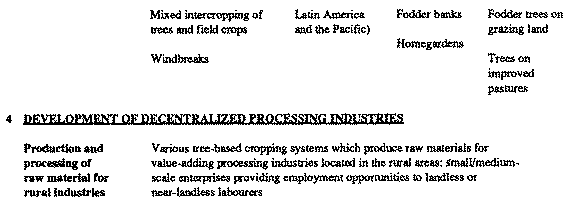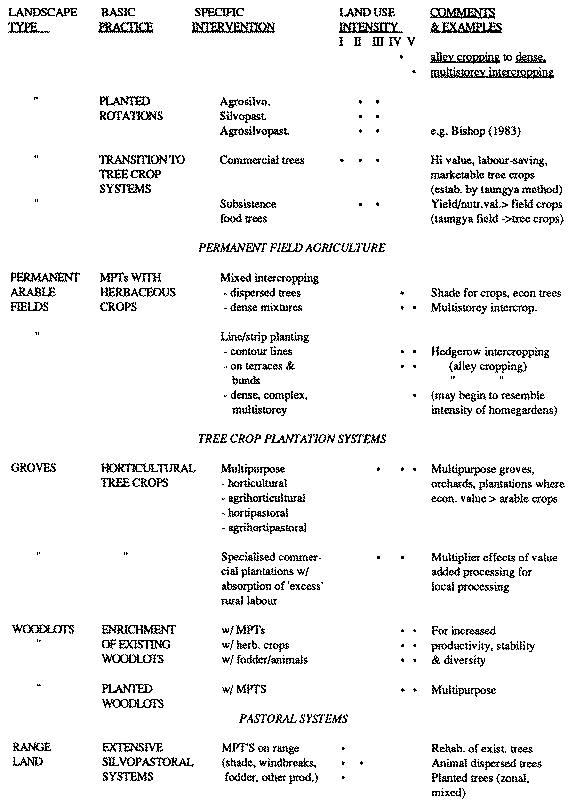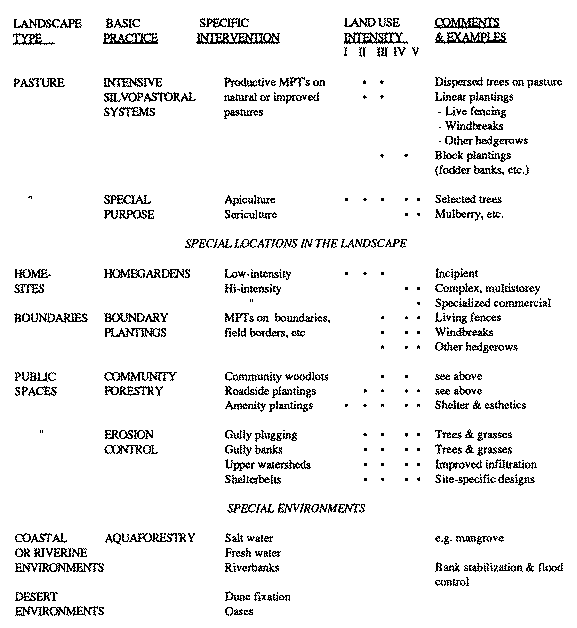


This appendix outlines two different and complementary approaches to the matching of tree growing technologies to different types of land users. But before presenting them, the first section attempts to clear the air of some common misconceptions.
The need to intensify agricultural land-use discourages the incorporation of trees into farming systems.
Some agroforestry technologies (e.g. planted fallows, mixed intercropping, hedgerow intercropping may themselves be ways of intensifying agricultural production.
Labour requirements of trees are low compared to other other crops.
Labour requirements for some agroforestry cropping systems, e.g., hedgerow intercropping, are clearly higher per acre than the simpler agricultural cropping systems which they are intended to replace. Where it is valid to recommend such systems as a way of intensifying agricultural production without heavy capital inputs, per acre yields of the agricultural crop will also tend to be higher. Yields per work-day could be either higher or lower, depending the particular design and on a number of technical variables that are not yet well understood or quantified for many of these technologies. In any case, generalizations about the labour requirements of "tree growing" tend to be meaningless, since labour requirements may vary as much between different tree-based cropping systems as between tree-based and other cropping systems.
Trees are convenient as cash crops because they can be harvested when the need for cash arises or any time the farmer has little else to do.
Try telling that to a farmer who has planted fruit trees. Clearly, it depends on the type of tree.
Where there is an abundance of agricultural labour and where opportunities for off-farm employment are scarce, smallholders who want to maximize returns to land would do better to plant agricultural crops rather than trees.
This is not the experience of the eucalyptus planters in the dry areas of India where the rainfed agricultural crops they replaced were at that time of lower value than eucalyptus grown as a cash crop for sale to industry. Nor is it consistent with conversion from short fallow shifting cultivation to cash crop fruit orchards reported in the Philippines, with an increase in returns to both land and labour (Eder 1981). The generalization may often be true for trees which produce only low value wood products in areas where, given sufficient labour and/or capital inputs, high value agricultural crops could be grown--but it is less likely to be true for horticultural tree crops.
Variations in the motivation of land users to adopt different tree growing innovations can be entirely predicted by evolutionary theories of land use intensification under population pressure (Boserup 1965,1981; Greenland 1974; Raintree and Warner 1986).
No claim to this effect is made by the proponents of evolutionary theories of intensification, although the position has been attributed to them by both supporters and critics. Such theories seek to call attention to meaningful regularities within the broad patterns of land use change and to avoid the most common types of "mismatch" error which result from ignorance of these patterns (e.g., recommending alley cropping in situations which favour extensive land use). Population pressure is unquestionably one of the driving variables behind the broad historical patterns of land use intensification. As such it exerts an important influence on individual decisions, but it is not the only factor. Decision aides based on the concept of "intensification pathways" provide broad guidelines may help orient the professional designer of tree growing interventions to an important evolutionary pattern, but they cannot predict individual adoption behaviour any more than Boyle s Law can predict the behaviour of individual gas molecules. Guidelines derived from this theoretical framework may be useful as a source of working hypotheses about "what fits where," but numerous other situation-specific factors have to be taken into account before recommendations can be made.
Tree planting can be a means of capital formation which is accessible even to poor farmers, as long as they have secure tenure over the land on which the trees are planted or, in some cases, simply tenure over the trees and their products. Trees as a form of capital can also substitute for labour, thus reducing drudgery and bringing about a more favourable balance of production factors for the smallholder (see Figure 2). Compared to most other forms of capital, trees have the advantage of being self-regenerating.
Unfortunately, tree-based development pathways are not always accessible to those who could benefit most from them. The eucalyptus controversy has alerted us to the potentially adverse effects of labour substitution by capital in the form of trees on the welfare of landless labourers. On the other hand, technologies like mulberry-based sericulture show us also that labour-intensive tree crops can be used to create employment opportunities for the landless if combined with valued-adding processing in the rural areas. In the general case, when land becomes scarce relative to labour the focus of labour-absorbing development opportunities is likely to shift from primary production to secondary processing activities, if a supportive environment exists for rural industrial development. Development of synergistic linkages between rural industry and agroforestry production systems is a promising area for increased attention in the search for ways to absorb rural population growth.
Matching tree growing practices to users
Arnold (1987) has analyzed the role of different combinations of scarcities of land, labour and capital and shown how these patterns of factor scarcity can help explain the complexities of farmer decision-making vis-d-vis tree planting. Based on an analysis of selected case studies, he offers the following provisional generalizations regarding five discernible farmer motivations for incorporating trees into their land use strategies:
1. to maintain productivity of land in situations of scarce capital where the presence of trees can help substitute for purchased inputs of fertiliser and herbicide and investments in soil and crop protection;
2. to make productive use of land in situations of scarce capital and labour where trees, as low-input low management crops, constitute the most effective use of these resources;
3. to increase usable biomass outputs per unit of land area in situations where land and capital are limited, and tree/crop/livestock combinations permit fuller use of available labour than alternative uses of the land;
4. to increase income-earning opportunities from use of farm resources as size of landholding and/or site productivity fall below the level at which the household's basic needs can be met from on-farm production;
5. to strengthen risk management through diversification of outputs, wider seasonal spread of inputs and outputs, and build-up of tree stocks which can be sold in order to meet periodic or unforeseen needs for capital.
Using these working hypotheses as a take-off point for an expanded set of user categories and technology options, we may venture to suggest the following provisional matching scheme.
(CAP = capital, LAB = labour; the dots indicate which factors are scarce and to what degree; 3 dots = very scarce.)
# |
CONSTRAINTS CAP LAND LAB |
USER |
OBJECTIVE |
ROLE OF TREES |
ECONOMIC STRATEGY |
TECHNOLOGY |
1 |
All landed farmers |
Capital based production |
Trees as capital assets |
Cap. formation, lab. substitution |
Tree crops | |
2 |
All landed farmers |
Sustainable production |
Substitute for purchased inputs |
Use biological inputs |
Agroforestry intercropping | |
3 |
Large farmers |
Income (surplus) |
Low labour production |
Expand production |
Cap. intensive farming,woodlots | |
4 |
Largefarmers |
Income(surplus) |
Low input, lowlabour production |
Expand extensiveproduction |
Woodlots, etc. | |
5 |
Smallfarmers |
Subsistenceplus income |
Sustain, diversify& increase prod. |
Intensification |
Various AF,woodlots, etc. | |
6 |
|
Marginalfarmers |
Subsistencesecurity |
Increase &diversify prod. |
Intensification |
Diversifiedhomegardens |
7 |
Marginalfarmers |
Income(subsist) |
Raw material for cottage industry |
Intensive cottageindustry |
Specializedhomegardens | |
8 |
|
Marginalfarmers |
Absenteeincome |
Low input, lowlabour production |
Off-farmemployment |
Woodlots, etc. |
9 |
|
Landless(house plot) |
Subsistencesecurity |
Increase &diversify prod. |
Hyper-intensification |
Diversifiedhomegardens |
10 |
|
Landless(house plot) |
Income(subsist) |
Raw material forcottage industry |
Intensive cottageindustry |
Specializedhomegardens |
A simplified matching approach for settled agricultural areasWith the foregoing perspectives as background we are now in a position to increase the specificity of the available matching tools and suggest a simple decision tree for use as an aid in identifying candidate technologies for further consideration. Figure 3 highlights the most promising tree-growing technologies for different kinds of farmers (see Table 10 for an explanation of the tripartite division of farmers with which this decision tree begins). No suggestion is made that these are the only appropriate technologies, nor even that the technologies identified using this key will always be appropriate. The key should be used to generate working hypotheses to serve as starting points for local trials.
To use Figure 3 to match technologies to users, simply trace out the client's situation with respect to land, capital and labour resources ("+" means that the resource is abundant, "- " means that it is scarce; no technology listing is given where the combination is illogical or too rare to warrant consideration, e.g., landless labourer with abundant capital). The letters represent the following technologies:
A |
mixed intercropping |
H |
shelterbelts |
O |
hedgerow |
B |
dispersed trees in grazing |
I |
tree crops on boundaries |
intercropping | |
C |
homegardens |
J |
trees on paddy bunds |
P |
enriched fallows |
D |
woodlots |
K |
living fences |
Q |
leys |
E |
orchards |
L |
windbreaks |
R |
taungya |
F |
fodder banks |
M |
trees along waterways |
S |
tree nurseries |
G |
contour strips |
N |
trees on conservation structures |
T |
cottage industries |
Economic factors are not the only factors. But they can be important as a source of baseline expectations against which to compare actual behaviour. Deviations from economic expectations signal the presence of other decision making factors which need to be investigated.
These same kinds of considerations are entailed the second, larger-scale evolutionary approach which is presented here as a complement to the foregoing microeconomic approach.
The theory of the evolution of tropical land use systems as a function of population pressure on resources has been developed by Boserup (1965, 1981) and Greenland (1974) and extended to agroforestry systems by Raintree and Warner (1985, 1986). The theory is based on the now widely acknowledged observation that traditional farmers are rational decision makers and will change their land use technology only if circumstances make it rational for them to do so. Imperfect knowledge of the alternatives, or "nonrational" aspects of information processing (i.e., "extension problems" per se rather than problems of technological "mismatch") may undermine the operation of economic rationality and diminish the predictive power of the theory. The theory applies with greatest explanatory power to traditional, subsistence-oriented production systems, and must be applied with caution to situations in which strong commercial or "social production" motivations predominate, or where manufactured inputs replace land and human labour as the critical factors of production.
With these caveats in mind, the essential points of this theory are as follows: In response to mounting population pressure which cannot be relieved by migration, technological changes resulting in higher outputs per unit of permanently cultivated land have tended to be accompanied by lower yields per unit of labour. Thus, adoption of progressively more land- and labour-intensive technologies must be described as a "reluctant evolution," a process that moves uphill against the rational tendency of subsistenceoriented farmers to resist the adoption of more intensive practices as long as extensive, less labour-requiring alternatives are still able to satisfy their production objectives. When offered a choice of land use options of differing labour intensity, subsistence- oriented farmers will first choose the least labour-intensive methods of meeting their production needs and will be reluctant to adopt more labour-intensive practices until population pressure alters the land-labour balance and compels them to do so.
Ignorance of this dynamic is probably responsible for more mismatches than any other factor in externally supported agricultural development projects. Trying to introduce a technically elegant and environmentally sustainable but highly labour-intensive technology to farmers accustomed to much less intensive farming methods is like trying to fit the proverbial square peg into a round hole (Raintree 1989).
The simplest approach to application of this perspective is a common-sense, qualitative analysis of the number of operations involved in converting a resource into a product. The normal order of preference would be: first gather the product directly from nature's abundance as long as it is available (i.e., where the product itself is a resource), and only when nature ceases to provide invest the additional labour to produce the product, taking advantage of labour-saving natural processes and inputs; finally, only when yields decline because the naturally available inputs are insufficient, produce the inputs to produce the product.
Assuming they are still in possession of the requisite cultural knowledge, traditional farmers will generally prefer to take advantage of natural processes (e.g., using the fertility restoring functions of fallow as a means of soil management) rather than accept the higher labour, management and other input costs of a "do-it-yourself' or "manufactured" approach to agriculture. Modern farmers, lacking an appreciation of natural processes or simply wanting to make their farms like factories, see no problem with a high-input approach as long as the bottom line is favourable. But traditional farmers, with a keen appreciation of "process as resource" (Alcorn 1989), see greater farming efficiencies in going along with nature.
This explains why a labour-intensive technology like "alley cropping," which uses leguminous trees to grow an input (fertiliser) for the associated crops, is not being adopted everywhere it has been introduced. It can be expected to appeal only to farmers at the upper end of the intensification sequence.
A general matching scheme based on these kinds of considerations is given in Figure 4 for the most prominent agroforestry interventions in tropical farming systems.
Different agroforestry options open up from different evolutionary stages in the main suiuence of tropical land use systems. The R index (Joosten 1962, Ruthenberg 1971) on the left gives an approximate indication of the land use intensities of the stages shown on the right. (Raintree and Warner 1986.)
Sources of production increase
Implicit in this perspective is the concept of potential sources of increased production in a given land use system. There are really only three main possibilities: 1) expansion of the area in cultivation, 2) increase in the frequency of cropping (i.e., reduction of the fallow period), and 3) increase in the yield per unit of permanently cultivated land. The FAO study of Agriculture: Toward 2000 estimates the projected contributions from these sources to growth in regional agricultural output by the year 2000 (see Table 22). One may quibble about the figures, but the projections are useful for a sense of the relative importance of the three different sources of production increase in the different regions.
Expansion of land in cultivation |
Increase in cropping frequency |
Increase in yields per unit of land | |
ASIA |
10% |
14% |
76% |
AFRICA |
27% |
22% |
51% |
LATIN AMERICA |
55% |
14% |
31% |
The most likely sources of production increase in any given land use system are relatively easy to assess. One simply looks at what new farmers are doing, or asks existing farmers a question like: "If you wanted to increase production, what would you do: get new land to cultivate, clear bigger fields and shorten the fallow period within your swidden land, or try to increase the yield per hectare of your permanently cultivated land?" This information provides an efficient entry point for an initial identification of candidate tree growing technologies. One would expect that, other things being equal, the preferred order of adoption of land use improvements will follow the general sequence from least intensive to most intensive, i.e., from expansion of land in cultivation to increase in the frequency of cropping to increase in yield per unit of permanently cultivated land.
Table 23 shows how trees in various agroforestry technologies may contribute to the goal of increased production in each of these scenarios, both indirectly through service functions within arable cropping systems and directly through various tree crop alternatives. The potential for employment generation in a fourth level of intensification, through agroforestry-based rural industry, is also indicated.

The next table elaborates on the scheme given in Table 23 and provides more detail on the criteria for matching agroforestry technologies to particular landscape niches within land use systems. These suggestions must be regarded as provisional until validated by local experience. See Raintree (1989) for a more detailed discussion of the decision criteria.
Table 24. Land use systems and relevant agroforestry interventions. (See explanation of land use intensity ratings at the bottom of the table.)


Note on land use intensity stages: Wherever possible, provisional indications are given of the stage of land use intensification at which the different practices are most likely to be applicable, based on the availability of appropriate landscape niches, compatibility with prevailing land use traditions and with customary labour intensities, among other factors associated with the adoptability of agroforestry interventions. The intensity index of a given area may represent the average of a mosaic of different field types, each with its own distinctive land use and labour intensities.
Stage I: |
Lowest intensity, associated with extensive forestry, "forest fallow" shifting cultivation or extensive pastoral systems |
Stage II: |
Typically associated with more intensive forestry, "bush fallow" systems or more intensive pastoral systems |
Stage III: |
Typically associated with "short fallow" or "ley" systems |
Stage IV: |
Typically associated with permanent annual cropping systems |
Stage V: |
Highest intensity, associated with multiple cropping systems, very high rural population densities, and increasing reliance on secondary industries to absorb rural labour |